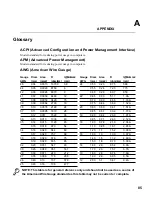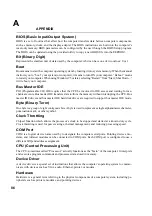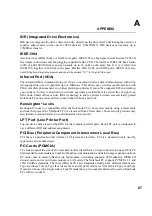
72
5. Configuring the BIOS
5
I/O Device Configuration (sub-menu)
I t e m S p e c i f i c H e l p
I / O D e v i c e C o n f i g u r a t i o n
I R P o r t
[ 2 F 8 H / I R Q 3 ]
M o d e
[ F I R ]
D M A C h a n n e l
[ 1 ]
P a r a l l e l P o r t
[ 3 7 8 H / I R Q 7 ]
M o d e
[ E C P + E P P ]
E C P D M A S e l e c t
[ 3 ]
< E n t e r > t o s e l e c t t h e
I / O A d d r e s s & I R Q f o r
I R .
NOTE: The presence of sub-items in this menu is dependent on certain relevant settings.
WARNING! Changing the default address and IRQ settings for Serial Port or Parallel
Port can cause conflicts with other system devices or installed peripherals.
IR Port: [2F8H/IRQ3]
This field allows you to configure the Notebook PC’s serial IR port. To enable this port, select an
address that does not conflict with another port. A conflict will be noted by red asterisks next to this
item and the item in conflict with. The configuration options are:
[3F8H/IRQ4] [2F8H/IRQ3] [3E8H/IRQ4] [2E8H/IRQ3] [Disabled]
Mode: [FIR]
The Mode field allows you to select either Standard Infrared (SIR) or Fast Infrared (FIR) commu-
nication mode. The configuration options are: [SIR] [FIR]
DMA Channel: [1]
The DMA Channel field allows you to configure the Parallel port DMA Channel for the selected
ECP mode. The configuration options are: [1] [3]
Summary of Contents for T9A
Page 11: ...10 About This User s Manual Notes For This Manual 1 Introducing the Notebook PC ...
Page 13: ...12 Top Side Bottom Side Left Side Right Side Rear Side Front Side 2 KNOWING THE PARTS ...
Page 81: ...80 APPENDIX Internal Modem Compliancy Glossary Owner Information ...
Page 84: ...84 APPENDIX A ...
Page 91: ...91 APPENDIX A ...
















































